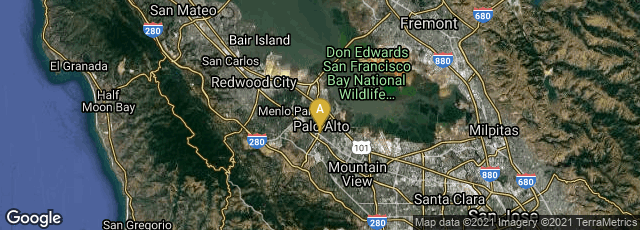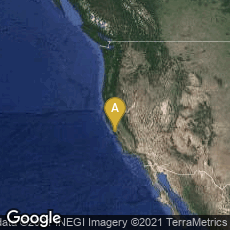

A: Palo Alto, California, United States
From 1964 to 1966 Woodrow W. "Bledsoe, along with Helen Chan and Charles Bisson of Panoramic Research, Palo Alto, California, researched programming computers to recognize human faces (Bledsoe 1966a, 1966b; Bledsoe and Chan 1965). Because the funding was provided by an unnamed intelligence agency, little of the work was published. Given a large database of images—in effect, a book of mug shots—and a photograph, the problem was to select from the database a small set of records such that one of the image records matched the photograph. The success of the program could be measured in terms of the ratio of the answer list to the number of records in the database. Bledsoe (1966a) described the following difficulties:
" 'This recognition problem is made difficult by the great variability in head rotation and tilt, lighting intensity and angle, facial expression, aging, etc. Some other attempts at facial recognition by machine have allowed for little or no variability in these quantities. Yet the method of correlation (or pattern matching) of unprocessed optical data, which is often used by some researchers, is certain to fail in cases where the variability is great. In particular, the correlation is very low between two pictures of the same person with two different head rotations.'
"This project was labeled man-machine because the human extracted the coordinates of a set of features from the photographs, which were then used by the computer for recognition. Using a GRAFACON, or RAND TABLET, the operator would extract the coordinates of features such as the center of pupils, the inside corner of eyes, the outside corner of eyes, point of widows peak, and so on. From these coordinates, a list of 20 distances, such as width of mouth and width of eyes, pupil to pupil, were computed. These operators could process about 40 pictures an hour. When building the database, the name of the person in the photograph was associated with the list of computed distances and stored in the computer. In the recognition phase, the set of distances was compared with the corresponding distance for each photograph, yielding a distance between the photograph and the database record. The closest records are returned.
"This brief description is an oversimplification that fails in general because it is unlikely that any two pictures would match in head rotation, lean, tilt, and scale (distance from the camera). Thus, each set of distances is normalized to represent the face in a frontal orientation. To accomplish this normalization, the program first tries to determine the tilt, the lean, and the rotation. Then, using these angles, the computer undoes the effect of these transformations on the computed distances. To compute these angles, the computer must know the three-dimensional geometry of the head. Because the actual heads were unavailable, Bledsoe (1964) used a standard head derived from measurements on seven heads.
"After Bledsoe left PRI [Panoramic Research, Inc.] in 1966, this work was continued at the Stanford Research Institute, primarily by Peter Hart. In experiments performed on a database of over 2000 photographs, the computer consistently outperformed humans when presented with the same recognition tasks (Bledsoe 1968). Peter Hart (1996) enthusiastically recalled the project with the exclamation, 'It really worked!' " (Faculty Council, University of Texas at Austin, In Memoriam Woodrow W. Bledsoe, accessed 07-2023).
Bledsoe, W. W. 1964. The Model Method in Facial Recognition, Technical Report PRI 15, Panoramic Research, Inc., Palo Alto, California.
Bledsoe, W. W., and Chan, H. 1965. A Man-Machine Facial Recognition System-Some Preliminary Results, Technical Report PRI 19A, Panoramic Research, Inc., Palo Alto, California.
Bledsoe, W. W. 1966a. Man-Machine Facial Recognition: Report on a Large-Scale Experiment, Technical Report PRI 22, Panoramic Research, Inc., Palo Alto, California.
Bledsoe, W. W. 1966b. Some Results on Multicategory Patten Recognition. Journal of the Association for Computing Machinery 13(2):304-316.
Bledsoe, W. W. 1968. Semiautomatic Facial Recognition, Technical Report SRI Project 6693, Stanford Research Institute, Menlo Park, California.